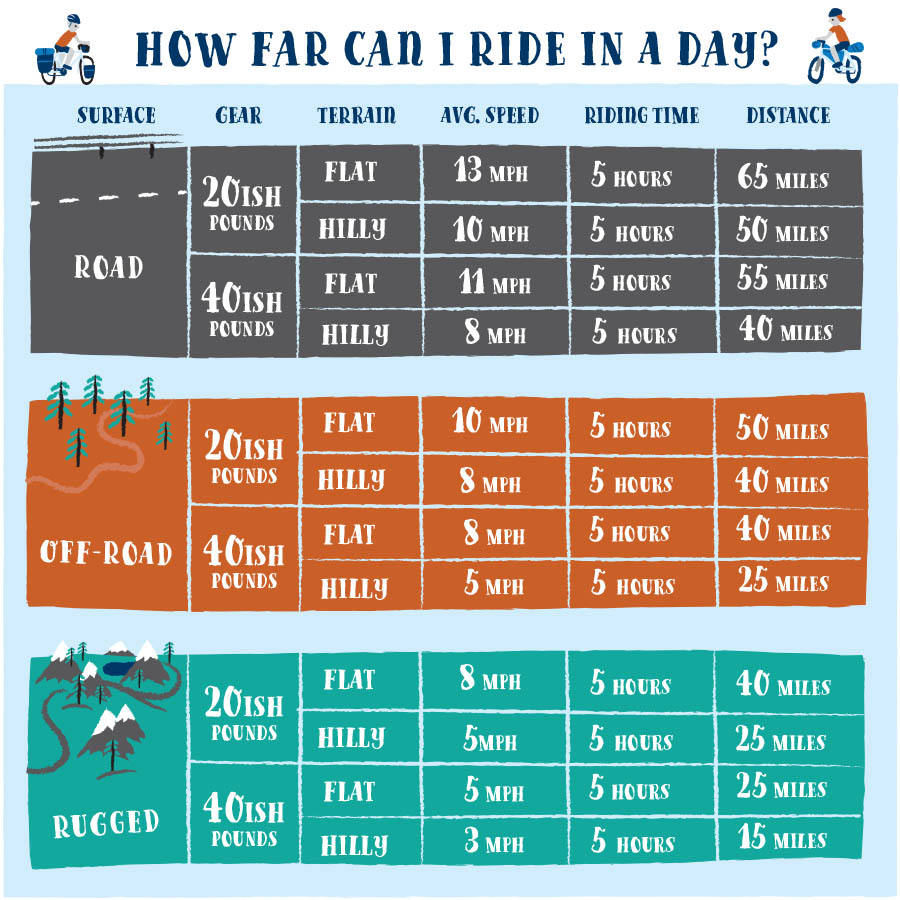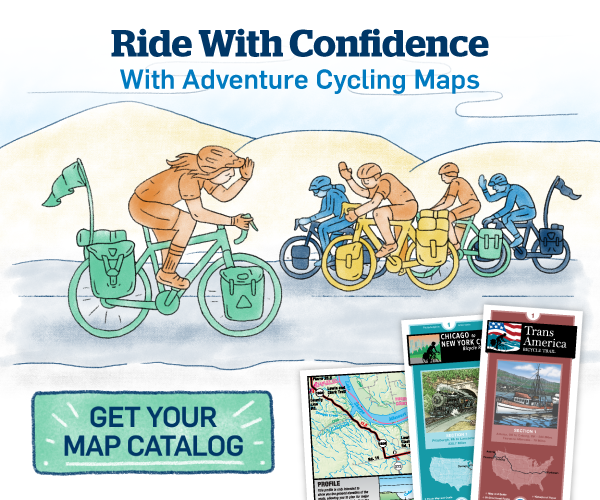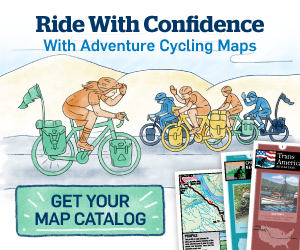Bike Touring 101
Experienced riders know the simplicity of bike travel is one of its great joys, but to the curious newcomer, this new world of possibility can appear bewildering. Let us demystify adventure cycling.
Who travels by bike?
Bicycle travel appeals to a broad spectrum of people and there are many ways to do it. It can be done individually, with friends, or with a commercial tour operator. People of all ages, backgrounds, and regions of the world choose the bicycle as their favorite means of travel.
Adults in their seventies and children in their teens (and younger!) have ridden all the way across America. Bicycle travel is attractive for many reasons: it’s an exciting challenge that allows us to explore new landscapes and cultures, build physical fitness, and experience the joy of breathing fresh air and meeting new people every day.
Am I in good enough shape?
The good news is that you don't need to be a super-athlete to enjoy cycling. However, you’ll want to spend some time training on a bike before your trip. The best thing to do is to be realistic about what you can do and create achievable goals. Then, work your strength up to riding the same daily distances you plant to cover while carrying the same gear you plan to travel with.
You’re physically ready if you can do back-to-back day rides that are as long or longer than you are planning for your tour, and feel like you could ride again on the third day. One of the pleasures of bike travel is that you’ll be riding into progressively better and better shape as you go.
How far can I ride in a day?
This varies depending on your overall fitness, your personal goals, the style of touring you choose, and the terrain. Here are some tips to plan by.
With a bit of bicycle-specific training, an average physically fit adult carrying less than 20 pounds of additional gear on their bike can expect to travel at an average pace of 65 miles per day on paved roads and still have time to stop and smell plenty of roses. With a load of gear totaling 20-45 pounds, the average pace to plan for should be lowered to 55 miles per day. If the terrain is particularly flat or mountainous, the average will increase or decrease accordingly. For mountain-bike travel, these distances can be cut in half, or more, depending on the ruggedness of the terrain.

Experienced bicycle travelers can ride farther, but for most people, planning to exceed these averages has a tendency to increase the physical challenge and decrease enjoyment. We recommend that you plan for at least one rest day out of ten, and carry no more than 45 pounds of gear, and a lot less if you can. Always plan time in your day, and days off in your trip, for unexpected challenges and good opportunities.
What kind of bike should I use?
Many types of bicycles can be used for touring. Although some bikes are specifically designed for touring, most quality bicycles can be customized for touring use, with the exception of road racing bikes, as they emphasize weight savings and quick handling over durability and comfort. (Folks do it, but we don’t recommend it for reliability reasons.)
Important characteristics of an appropriate bike are durability, a comfortable riding position, and low gears for climbing hills. The ability to mount racks, fenders, and wide tires (32 mm or greater) is also a plus.
Experienced bicycle travelers have their preferences, but there is no single style of bicycle that is an overwhelming favorite. Ultimately, your choice is based on personal preference and the style of touring you want to do (paved roads vs. dirt roads and trails, amount of gear to carry, etc.).
How do I decide where to ride?
Besides the obvious—scenery, history, and any other personal interests you have—look for low-traffic routes and/or roads with good shoulders. Keep in mind that many of the places you'd like to see by bicycle, such as national parks, can be choked with traffic and undesirable for cycling.
Mountain bikers usually look for routes with little or no motorized traffic and as little pavement as possible. The biggest question they need to answer is usually: Can all of the route be ridden with a loaded bike or trailer?
Many resources for finding bicycle-specific routes that emphasize safe roads and rideable trails can be found right here:
- Adventure Cycling's Bicycle Route Network and touring maps
- State resources, including tourism agencies, state bicycle/pedestrian offices, advocacy groups, and local bike clubs.
- Local and regional cycling maps and guidebooks listed under their respective states and countries.
How do I carry my stuff?
The most common methods of carrying gear are panniers and trailers. Panniers are luggage that attaches to your bicycle on racks that sit over or next to the wheels. Ortlieb and Arkel are two top-quality brands. Quality racks are available to fit nearly every bicycle.
Trailers come in many varieties, usually with one or two wheels. Most are easy to attach and fit on almost any bicycle. The BOB Yak/Ibex and Burley Nomad are both excellent choices.
Panniers excel on paved-road riding and single-wheel trailers are at their best on rough, unpaved terrain, but both can work well for nearly all types of touring. Personal preference is the ultimate arbiter.
Our best articles, twice a month, in your inbox.
Where do I stay at night?
First decide if you want to camp (inexpensive, independent, closer to nature) or stay in hotels (comfortable, less gear to carry).
Tourism agencies, chambers of commerce, convention and visitor’s associations, and many internet resources list information about motels, campgrounds, B&Bs, and other lodgings. Many maps and guides, including Adventure Cycling Bicycle Route Network maps, list local options.
Is it safe to travel around America alone?
Yes. Bicycle riders are typically perceived to be very non-threatening and are often treated warmly by strangers, especially during emergencies. The chances of something bad happening to you during a bicycle tour are likely to be no different than they are in your everyday life at home.
How much does bike touring cost?
The cheapest way to go is to camp and cook your own meals.
Assuming you have all the necessary gear before you leave, and you are touring in America, a budget of $35-$50 a day should be enough to pay for camping fees and groceries and still stash a bit away for unforeseen expenses like repairs or gear replacement. Going dirtbag-style, it’s possible to travel on $10/day or less.
For those with luxury in mind, well, the sky (and your bank account) is the limit. The beauty of bicycle touring is that it can be as comfortable or as adventurous as you want it to be.
This story has been updated and was originally published on December 22, 2015.


Comments
Here is a real simple question: what is the best way to keep your tires up to pressure on a long bike packing tour, with limited or no access to a real bike pump? We run tire pressures of about 85 psi on our tandem.
The easiest way is to run extremely heavy-duty tires with the thickest, heaviest tubes you can find. They should keep their air for a good long while, but even then, all tires and tubes are permeable. They'll lose pressure eventually.
Hi Alex ... I'm in the midst of planning/dreaming about a loaded, self-supported tour in Europe. Like most Americans, I have limited vacation time and tons of various responsibilities tugging at me. I'm hoping to visit three sets of friends over a few weeks with mostly bike travel and some train/bus/ferry/albatross where needed. The first friend is in London, second couple is in Lenzburg, Switzerland. The bulk of my riding would be from Hook of Holland/Rotterdam to Basel along the Rheinradweg and surrounding routes. This is where I get lost....
I started cycling in earnest in Hill County TX, and have been in Western Washington for over a decade. It's NOT flat here. It's difficult to find a long, flat route anywhere around here. I'm wondering how much MORE mileage I can ride on the flats of the Netherlands and the Rhein, where the average elevation gain is about 10 feet per mile (yes, ten). Assuming I can handle 50 a day loaded and 2500 feet of climbing, is 60-70 unreasonable if the climbing is 600/non-existent?
That sounds pretty reasonable to me, though you'll be betting on that pan-flat country not having any headwinds! Speaking for myself, training in the mountains of Western Montana usually allows me to add some considerable mileage on my legs for a flat route ... but my butt isn't always prepared for longer days in the saddle!
Awesome, thanks Alex! That's helpful.
We should really reconsider the panniers on racks. Thanks for the push.
I do love the idea of a trailer with a cooler, though! ;) We'd be riding through a mixed urban/rural area on a smooth path, but even then, we'd have some pretty shaken drinks by the end!
We're looking at doing a touring trip on the cap to cap ride in Virginia, so I've been reading through a lot of the posts on the site. Thanks! This post was a great place to start as a "getting started" guide.
So far as cost and "bang for the buck", in general, is there a specific weight when a trailer might be recommended for the length of daily rides mentioned versus a backpack? Naturally a trailer is going to be more manageable in general, but it certainly wouldn't make sense versus a 5 pound bag but almost certainly would with a hundred pounder. Any sense where that line might be?
Not sure there's a magic number, but we tend to see trailers on the heavier end of the spectrum. Depending on your bike and gear needs, you might consider a middle ground of some on-bike luggage (racks and pannier or soft bikepacking-style bags) instead of backpacks or trailers. Trailers can encourage overpacking (cough, coolers, cough), which may or not be a drawback depending on the experience you want!
Forgot Password?
Enter your email address and we'll send you an email that will allow you to reset it. If you no longer have access to the email address call our memberships department at (800) 755-2453 or email us at memberships@adventurecycling.org.
Not Registered? Create Account Now.